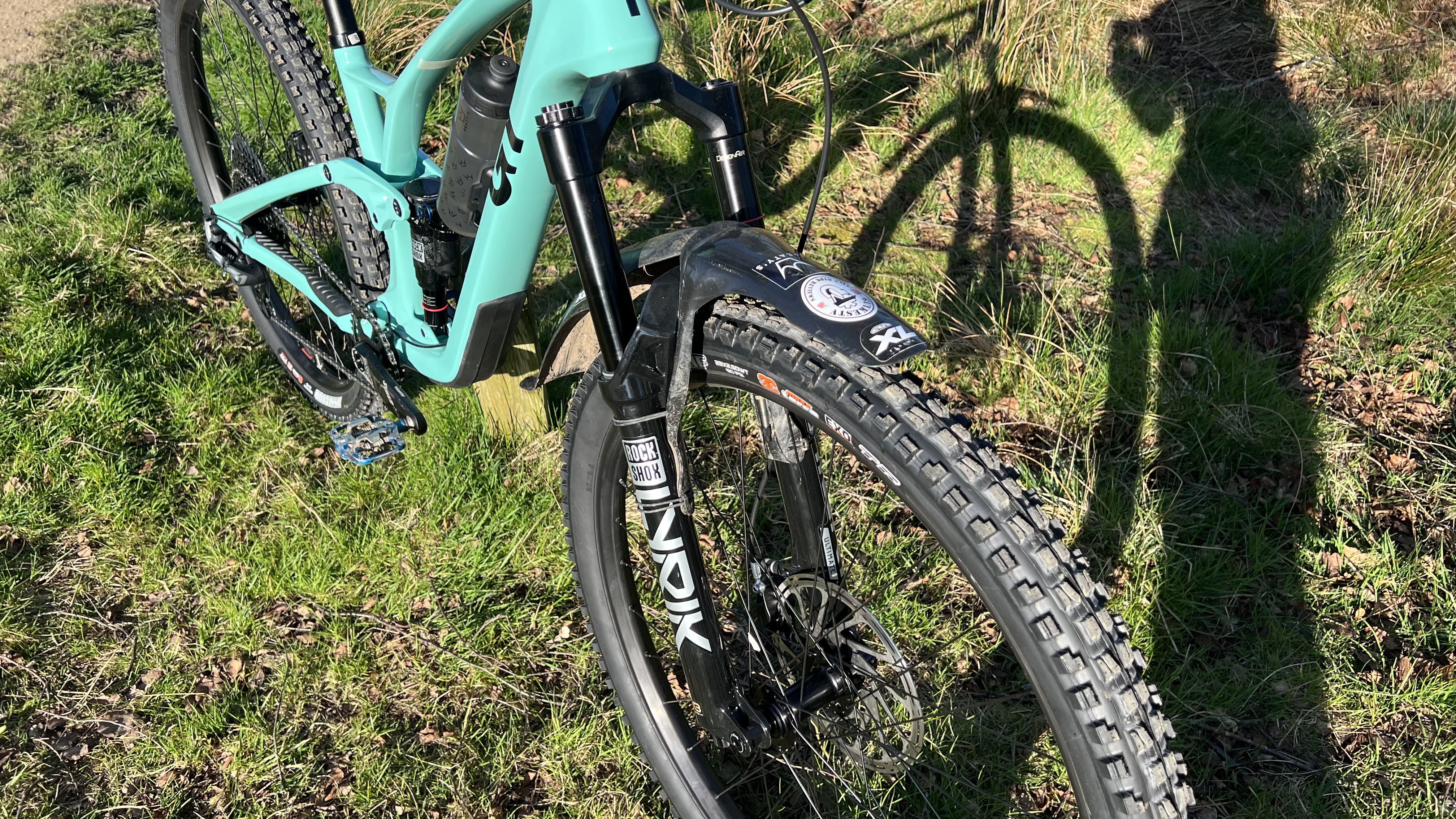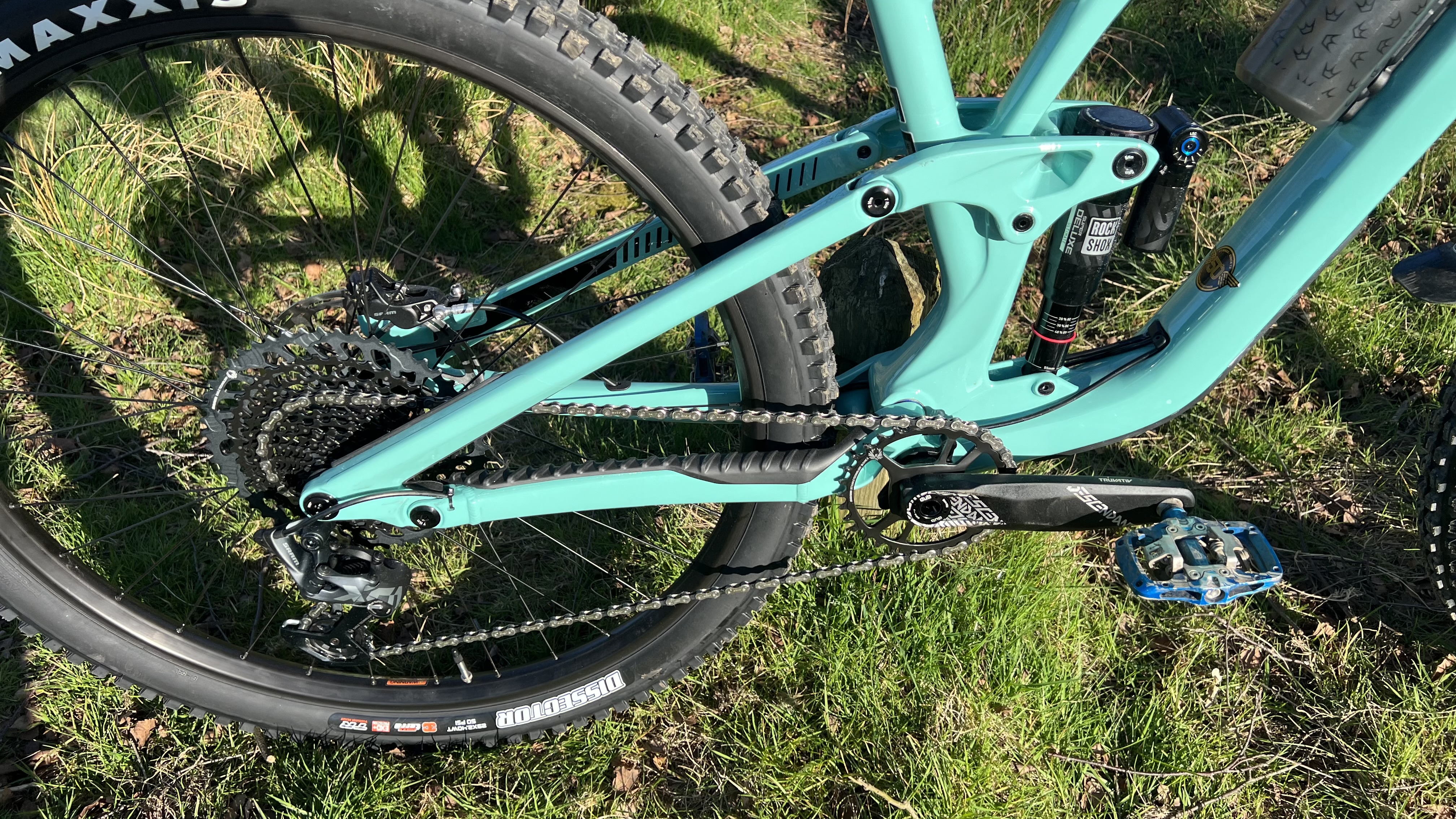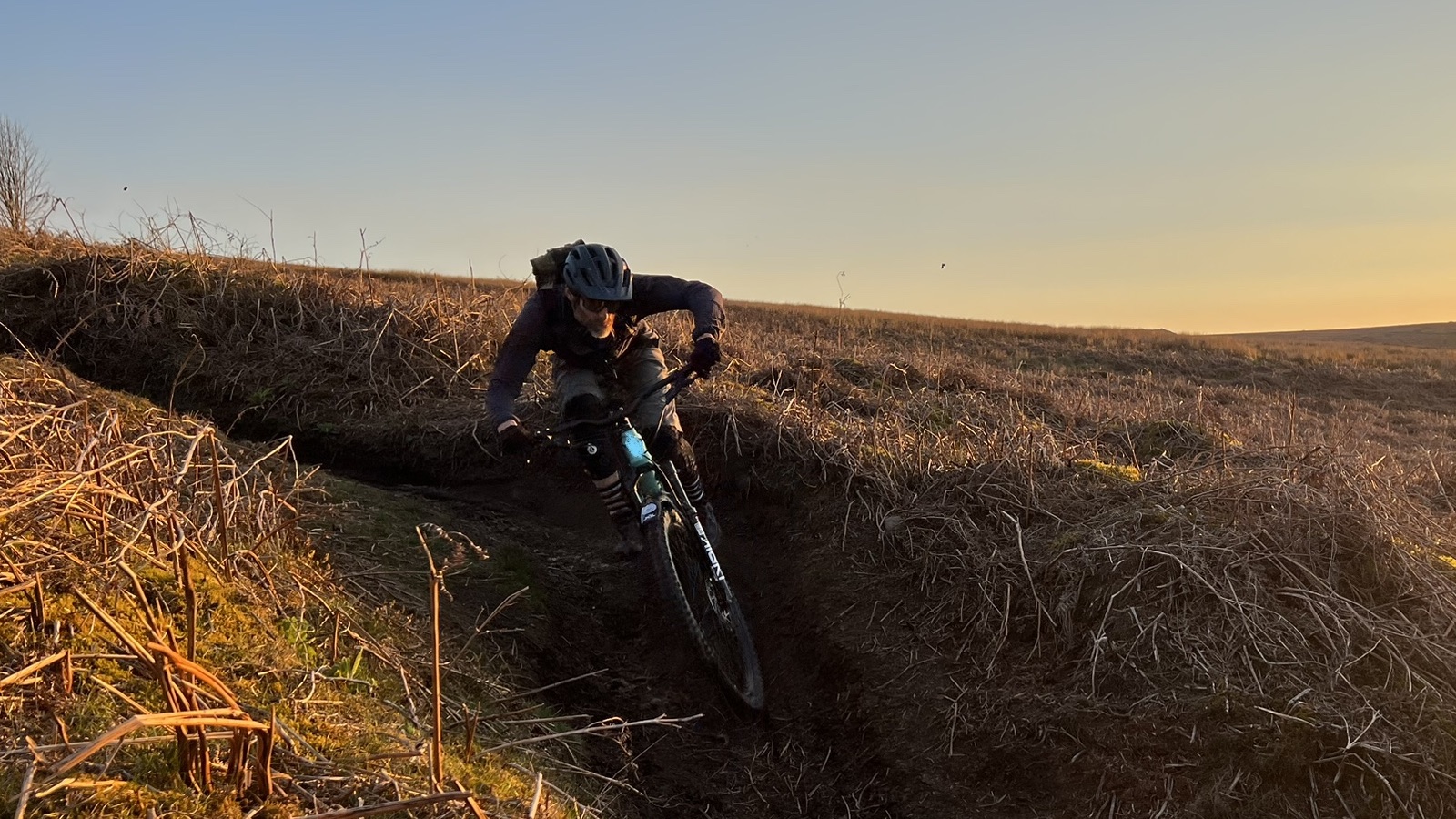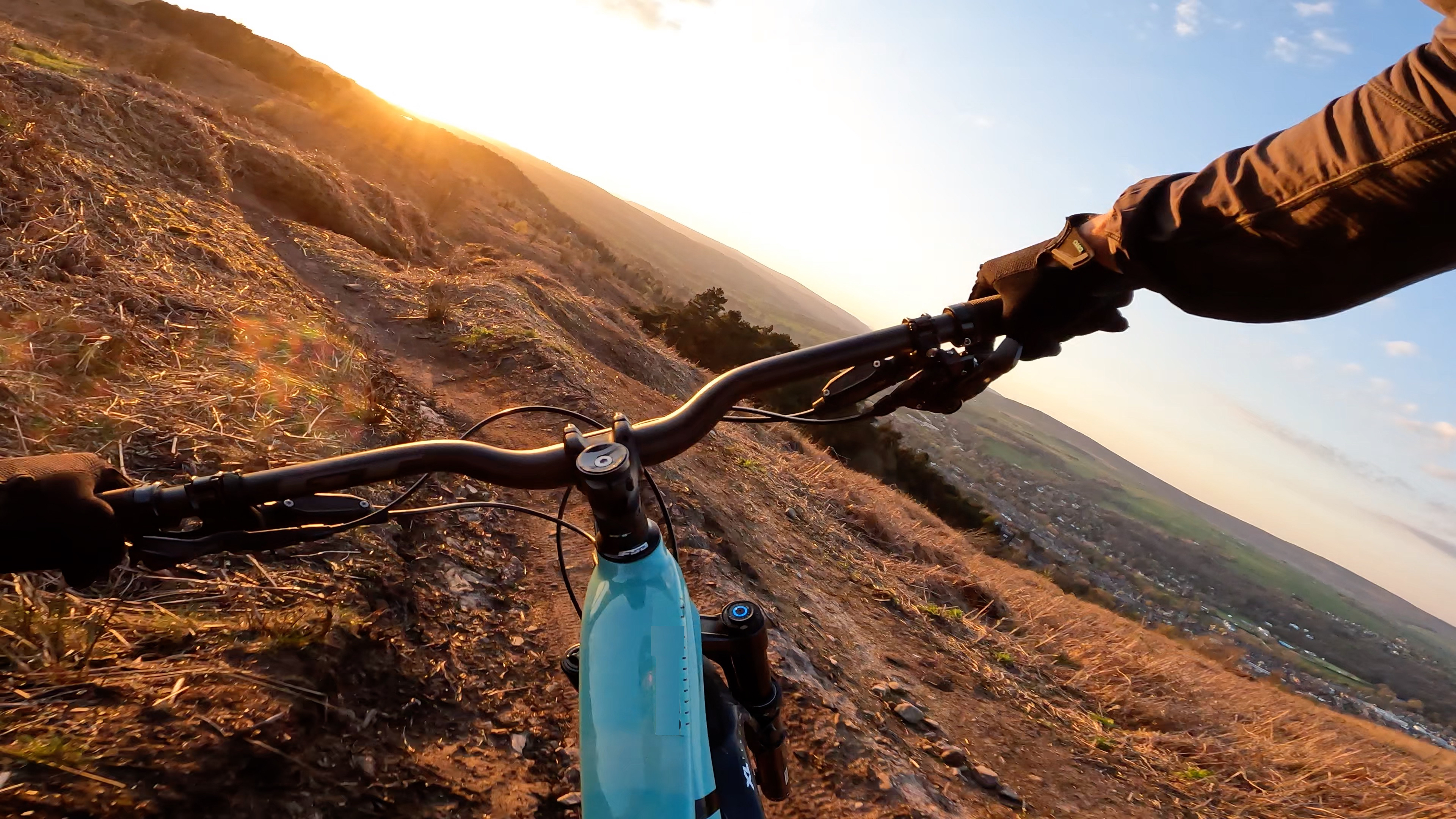Bike Perfect Verdict
Great shape and frame feel with naturally super smooth suspension and mostly excellent kit for the money. On the heavy side though and hustlers will definitely want a better rear hub
Pros
- +
Excellent performance for the price
- +
Super easy, drama-free descending speed and tech confidence
- +
Very well balanced, confident but engaging handling
- +
Top-class, finely adjustable, ride-optimizing suspension
- +
Enjoyably engaging frame feel with neat detailing
Cons
- -
Slightly heavy
- -
Super gappy, clunky free hub will upset some
- -
Full open suspension can feel soggy under power
- -
No internal storage or geometry adjust
- -
No XS or XXL sizes
Why trust BikePerfect
Sensor has been GT’s trail bike for a while but this latest update makes it a strong contender for best trail mountain bikes if you want to great value from an actual shop, not online.
The spec is particularly impressive, the geometry and frame feel are really sorted, and the suspension is impressively smooth, traction rich, and finely adjustable in feel. Riders who like to hustle will want a better rear hub though.

Design
The new Sensor Carbon gets a fresh composite layup and structural layout that’s very similar to the longer travel, high-pivot Force bike. This includes a flat ‘cobra head’ top tube that curves down into a sculpted lower seat stay section that includes the upper linkage pivot. The upper part of the seat tube is supported by a triangulating strut and the whole setup looks a lot like the latest Evil and Trek bikes even though GT were famous back in the day for their ‘Triple Triangle’ overshot stay design.
The main pivot sits just below and behind the chainring with another pivot at the end of the alloy chain stays creating a classic ‘Horst Link’ four-bar design. Increasing shock stroke from 50mm to 55mm on the trunnion-mounted shock boosts travel from 130 to 140mm. The seat stays are changed to carbon on the new frame too which together with refinement of the linkage means the frame drops 600g over the previous Sensor.
You still get a plastic armor panel under the belly and a ribbed chain slap protection on the seat and chain stays. All the pivot junctions are double-sided clevis designs and the gear, dropper post cables, and brake house route through the frame in molded tubes. There’s room for a full-size bottle inside the frame too as well as a removable alloy chain guide mount. There’s no internal storage or XS or XL frame sizes which keeps the price down.
The 65-degree head angle, 77-degree seat angle, and 440mm chain stays are the same across all sizes too rather than being proportionate, but reach changes from 430mm on the small, through 455mm medium and 480mm large then right out to 515mm for the XL. 380, 400, 420, and 460mm seat tubes give space for sizing up on reach even while running a long-stroke dropper.

Components
The 10mm increased rear travel is matched with a 150mm fork in front and you’re getting a top-spec RockShox Lyrik Ultimate to match the Super Deluxe Ultimate rear shock. The cable-operated gears are a mix of X01 and GX Eagle, turned with an alloy Truvativ crank running a 32-tooth ring. The dropper post stroke varies between 150mm and 200mm depending on frame size with the medium I tested getting a 170mm stroke, but the +Rad post is also adjustable by -30mm too. A short 35mm stem holds 31.8mm bars with a really early and accentuated 30mm rise that adds a comfy, easily lifted character to the front end. It’s also a reminder that GT first started off as Gary Turner’s BMX brand before becoming one of the biggest MTB brands in the 90s and 00s.
While GT lists stock spec as Continental’s Kryptotal Enduro Soft tires, my test sample came with a Maxxis DHF front and Dissector rear which gave their usual great balance of grip and speed. The brakes on my pre-embargo sample bike were also off-spec with SRAM G2 rather than the more powerful Code so check what you’re actually getting before you buy. Wheels use WTB KOM Trail i30 rims which are fine but the SRAM hub potentially has a big (18-degree maximum) lag before pick up and the 32 plain gauge spokes add weight too. That puts overall mass at a hefty 15kg but at £5k you’re getting outstanding value for money for a shop sold and supported, rather than a remotely delivered bike.
If the LE is still too pricey Sensor Carbon Pro and Sensor Carbon Elite drop the price to $4950 / £4200 and $3,800 / £3400 respectively while two alloy models with slightly steeper geometry come in at $2600 / £2500 (Comp) and $2300 /£2200 (Sport). There are two 120mm travel Sensor ST options at $5000 / £4000 and $3900 / £3350 as well which I'll hopefully be testing shortly.

Ride, handling and performance
The GT Sensor LE doesn't just show great value in its spec either. The geometry feels immediately familiar and well-balanced (it’s basically the same as a Santa Cruz Hightower in its taller/steeper setting). It’s long enough to center you for confidence but not so slack it loses interest in turning at slow speed and the shorter seat tubes and adjustable dropper stroke means it’s easy to size up if you do want more length. The 440mm rear end length is well proportioned to the front of the medium and large bikes too though that balance will be slightly out of kilter for S and XL frames.
The broad headed frame means enough stiffness to stick the front wheel wherever you want and then drive the DHF tire hard to hold that spot through turns, random rock heaps and it’s not nervous nailing deep, narrow ruts at speed. Clevis joints and alloy chain stays keep the back end similarly tight and trustworthy through turns or trying to crab a tight line across off-cambers or loose step-outs. The shallow, subtly curved tubes mean it’s not so stiff it blows your arms/hands up when the Lyrik has one of its occasional spikey moments. There’s enough spring to make it feel alive rather than dull and inert like a lot of ‘cost conscious’ - and even some boutique carbon frames I’ve tested.
The suspension is naturally easygoing even by four-bar FSR standards, so it’s worth playing around with the four-position low-speed compression dial if you want a firmer and more supportive vibe. Fully open it sucks down into its stroke slightly under power but gives a hovercraft smoothness over random jank/mini moguls. The potentially big gap in freehub pickup also reduces pedal pullback on big hits and drops so it handles stutter bumps and slap impacts well for a rear wheel that doesn’t move backwards much. Easy lean back into the suspension and higher rise bar makes bringing the nose up effortless at all speeds too. This adds to the alive frame vibe to create a bike that likes to throw some lazy steeze and style with gravity at its back. It can also rock crawl up steppy, lumpy climbs with very little pedal kickback or rhythm disturbance when I span smoothly.
Left fully open the relatively rearward, lower main pivot naturally takes the nose off the power phase of the pedal stroke and also combined with the overall weight to make longer power climbs a chore. The self-compression also makes the effective seat angle slacker so the front came up and/or wandered frequently in full open so I found myself weighting the front end more than normal on climbs.

While suspension feel is definitely a personal thing I like to be aggressive on climbs so I’m not a fan of squishy bikes. Happily for me running the damper with full low-speed compression adds enough support to crank the pedals hard without excess bob and there’s always the pedal lever if you really want to snuff out movement. The sophisticated sequential (rather than parallel) low and high-speed damping flow inside the Super Deluxe means it’s still not obviously harsh or chattery even at full firm either. It does lose some traction through loose turns though and with limited mechanical feedback it still tended to spin the rear wheel earlier than I expected. That meant I kept it fully wound on for trails with lots of linked berms or compressions that I wanted to sit higher and harder on. Otherwise, the +1 and 0 settings soon became my go-to for zero drama, consistent traction, and easy flow through on random/erratic off-piste trails where hard berm turns fired into ugly rock gardens or blind sends. Even without the hydraulic bottom-out damper RockShox offers as an option for this shock, it never clanged out obviously at full travel either although real senders will likely want a volume spacer or two to change the progression. Up front, the Lyrik also benefits from time spent playing with the widely adjustable damping and pressures too, but if you keep it in the center like the rear shock you’ll be in its stealthily silent and racily poised sweet spot most of the time.
Apart from adequate rather than amazing power from the G2 brakes (remember it should have Codes) and a spongey feel from the TransX dropper lever the spec is mostly really positive. Even the alloy chainset was a relief when the naturally low ride height meant clattered crank tips that would be worrying with carbon. While the 32T ring is good for pedaling fast descents switching to a 30T ring reduced the power squat slightly too so I’d probably stick with that if I kept the bike for a while.
That leaves the only serious glitch as the gappy freehub which was really obvious and irritating when trying to hustle hard. The abrupt slam and sudden suck down when it did engage also caused some sketchy stumbles towards the bars in extreme moments. The undermining effect it was having was really brought home when I switched to a set of Reserve 30SL wheels with a considerably faster freehub reaction and lighter weight. That instantly made the GT much more rewarding to hustle under power and while less free movement before pedal connection did make it more stutter prone through big slap hits, it wasn’t excessive. Plus if you’re going to be going fast and hard through sizeable geology most of the time you’ll probably want GT’s high pivot Force bike with more travel in a more rearward axle path and a bigger impact appetite as a result.

Verdict
GT’s Sensor is at the heavier, relaxed rather than rushed vibe end of the trail spectrum and it definitely deserves better wheels. Its balance of deceptively easy speed and consistent control with engaging accuracy and agility make it a really enjoyable descender and all-around tech player though. Top flight suspension unlocks an extra layer of more aggressive character tweaking and overall spec levels and value are excellent for a bike that comes with proper shop support not just in a cardboard box. I’m also probably guilty of being overly picky about the nuance of the rear wheel/suspension feel too, as the consistent take home from testing was that the Sensor consistently got me from top to bottom of the hill stress-free and laughing. The fact that riders who normally give me a hard time were having a hard time keeping up/staying on themselves was a surprise bonus too and I’d be really happy to keep the Sensor on as a good-time all-rounder if I was given the chance.
Test conditions
- Surface: Loam, rock gardens, grass, kitty litter, mud, tarmac climbs
- Trails: Red/Black off-piste descents and singletrack
- Weather: 8 degrees, sunny, dry to moist trails

Tech spec: GT Sensor Carbon LE
- Discipline: Trail
- Price: $5750 / £5000
- Size: S, M (tested), L, XL
- Head angle: 65 degrees
- Seat tube angle: 77 degrees
- Reach: 455mm
- Weight: 15.07kg
- Wheel size: 29in
- Frame material: GT Sensor Carbon
- Fork: RockShox Lyrik Ultimate RC2, 150mm travel
- Shock: RockShox Super Deluxe Ultimate RC2T, 140mm travel
- Cranks: Truvativ Descendant 6K 32T, 170mm chainset with DUB threaded bottom bracket.
- Derailleur: SRAM XO1 12-speed rear mech
- Shifter: SRAM GX Eagle 12-speed shifter
- Chain: SRAM XG-1275 12-speed 10-52T cassette.
- Brakes: SRAM Code RSC hydraulic disc brakes with 200/180mm rotors.
- Rims: WTB KOM Trail i30 rims
- Hubs: Formula front hub, SRAM MTH746 rear hub
- Tires: Maxxis DHF Exo 29x2.5in front and Maxxis Dissector Exo 29x2.4in rear tires
- Handlebar: GT Alloy 780 x 31.8mm riser bar
- Stem: GT Alloy 35 x 31.8mm stem
- Grips: GT Mushroom LockOn grips
- Seat post: TranzX +Rad 170mm dropper seat post
- Saddle: WTB Silverado saddle

Guy Kesteven has been working on Bike Perfect since its launch in 2019. He started writing and testing for bike mags in 1996. Since then he’s written several million words about several thousand test bikes and a ridiculous amount of riding gear. He’s also penned a handful of bike-related books and he reviews MTBs over on YouTube.
Current rides: Cervelo ZFS-5, Specialized Chisel, custom Nicolai enduro tandem, Landescape/Swallow custom gravel tandem
Height: 180cm
Weight: 69kg

